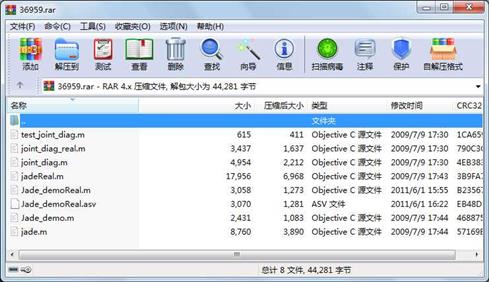资源简介
利用联合对角化技术进行信号盲分离,即JADE算法。希望对大家有帮助。

代码片段和文件信息
function [AS]=jade(Xm)
% Source separation of complex signals with JADE.
% Jade performs ‘Source Separation‘ in the following sense:
% X is an n x T data matrix assumed modelled as X = A S + N where
%
% o A is an unknown n x m matrix with full rank.
% o S is a m x T data matrix (source signals) with the properties
% a) for each t the components of S(:t) are statistically
% independent
% b) for each p the S(p:) is the realization of a zero-mean
% ‘source signal‘.
% c) At most one of these processes has a vanishing 4th-order
% cumulant.
% o N is a n x T matrix. It is a realization of a spatially white
% Gaussian noise i.e. Cov(X) = sigma*eye(n) with unknown variance
% sigma. This is probably better than no modeling at all...
%
% Jade performs source separation via a
% Joint Approximate Diagonalization of Eigen-matrices.
%
% THIS VERSION ASSUMES ZERO-MEAN SIGNALS
%
% Input :
% * X: Each column of X is a sample from the n sensors
% * m: m is an optional argument for the number of sources.
% If ommited JADE assumes as many sources as sensors.
%
% Output :
% * A is an n x m estimate of the mixing matrix
% * S is an m x T naive (ie pinv(A)*X) estimate of the source signals
%
%
% Version 1.5. Copyright: JF Cardoso.
%
% See notes references and revision history at the bottom of this file
[nT] = size(X);
%% source detection not implemented yet !
if nargin==1 m=n ; end;
%%%%%%%%%%%%%%%%%%%%%%%%%%%%%%%%%%%%%%%%%%%%%%%%%%%%%%%%%%%%%%%%
% A few parameters that could be adjusted
nem = m; % number of eigen-matrices to be diagonalized
seuil = 1/sqrt(T)/100;% a statistical threshold for stopping joint diag
%%%%%%%%%%%%%%%%%%%%%%%%%%%%%%%%%%%%%%%%%%%%%%%%%%%%%%%%%%%%%%%%
%%% whitening
%
if m
[puissk]=sort(diag(D));
ibl = sqrt(puiss(n-m+1:n)-mean(puiss(1:n-m)));
bl = ones(m1) ./ ibl ;
W = diag(bl)*U(1:nk(n-m+1:n))‘;
IW = U(1:nk(n-m+1:n))*diag(ibl);
else %assumes no noise
IW = sqrtm((X*X‘)/T);
W = inv(IW);
end;
Y = W*X;
%%%%%%%%%%%%%%%%%%%%%%%%%%%%%%%%%%%%%%%%%%%%%%%%%%%%%%%%%%%%%%%%
%%% Cumulant estimation
R = (Y*Y‘ )/T ;
C = (Y*Y.‘)/T ;
Yl = zeros(1T);
Ykl = zeros(1T);
Yjkl = zeros(1T);
Q = zeros(m*m*m*m1) ;
index = 1;
for lx = 1:m ; Yl = Y(lx:);
for kx = 1:m ; Ykl = Yl.*conj(Y(kx:));
for jx = 1:m ; Yjkl = Ykl.*conj(Y(jx:));
for ix = 1:m ;
Q(index) = ...
(Yjkl * Y(ix:).‘)/T - R(ixjx)*R(lxkx) - R(ixkx)*R(lxjx) - C(ixlx)*conj(C(jxkx)) ;
index = index + 1 ;
end ;
end ;
end ;
end
%% If you prefer to use more memory and less CPU you may prefer this
%% code (due to J. Galy of ENSICA) for the estimation the cumulants
%ones_m = ones(m1) ;
%T1 = kron(ones_mY);
%T2 = kron(Yones_m);
%TT = (T1.* conj(T2)) ;
%TS = (T1 * T2.‘)/T ;
%R = (Y*Y‘)/T ;
%Q = (TT*TT‘)/T - kron(Rones(m)).*kron(ones(m)conj(R)) - R(:)*R(:)‘ - TS.*TS‘ ;
%%%%%%%%%%%%%%%%%%%%%%%%%%%%%%%%%%%%%%%%%%%%%%%%%%%%%%%%%%%属性 大小 日期 时间 名称
----------- --------- ---------- ----- ----
文件 8760 2009-07-09 17:44 jade.m
文件 2431 2009-07-09 17:44 Jade_demo.m
文件 3070 2011-06-01 16:22 Jade_demoReal.asv
文件 3058 2011-06-01 15:55 Jade_demoReal.m
文件 17956 2009-07-09 17:43 jadeReal.m
文件 4954 2009-07-09 17:30 joint_diag.m
文件 3437 2009-07-09 17:30 joint_diag_real.m
文件 615 2009-07-09 17:30 test_joint_diag.m
----------- --------- ---------- ----- ----
44281 8
- 上一篇:计算机组成原理 自考
- 下一篇:16位单周期CPU设计_1
 川公网安备 51152502000135号
川公网安备 51152502000135号
评论
共有 条评论